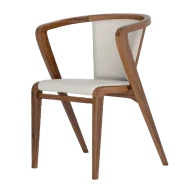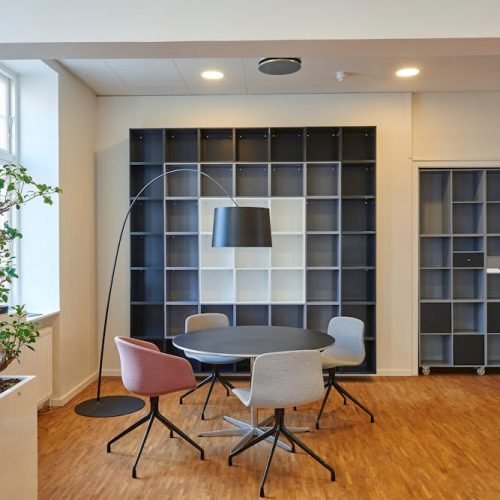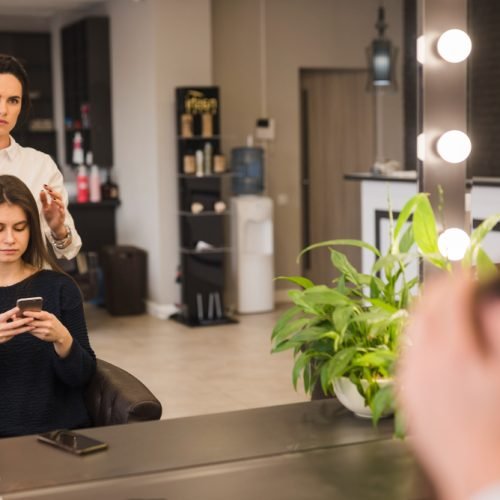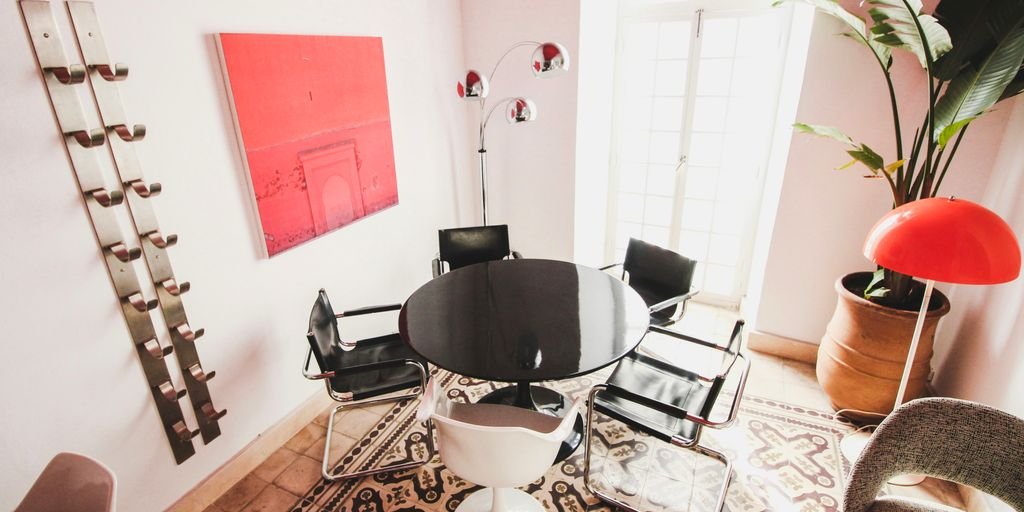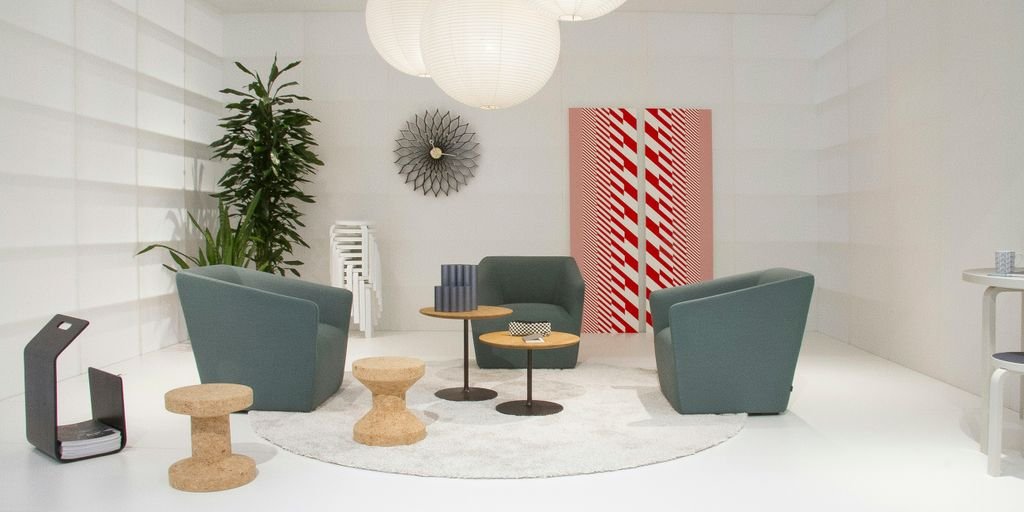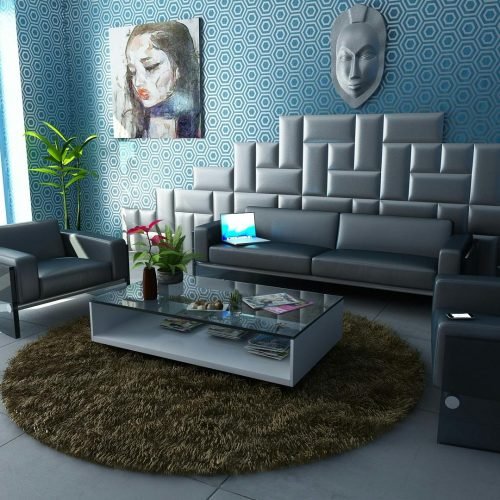The way we work is changing, and so is the look of our offices. For 2025, interior design office trends are all about making spaces that work better for everyone. Think adaptable layouts, more plants, and tech that actually helps. It’s less about rigid cubicles and more about creating environments where people feel good and can get their best work done. Whether you’re planning a big office overhaul or just a few updates, these ideas can help shape a workspace that’s ready for the future.
Key Takeaways
- Flexible workspaces that can change easily for different tasks and team sizes.
- Bringing nature indoors with plants and natural light to improve mood and focus.
- Using eco-friendly materials to create healthier and more responsible workplaces.
- Integrating smart technology for better comfort and efficiency.
- Focusing on quiet areas and sound-absorbing materials to reduce noise and boost concentration.
1. Flexible Workspaces
Forget those old-school offices where everyone had their own assigned cubicle. That whole setup is pretty much a thing of the past. In 2025, it’s all about making spaces that can change and adapt. Think about it: different teams need different setups, and sometimes you just need a quiet spot to focus, other times you need a big area for everyone to brainstorm. Flexible workspaces let you do just that. It’s about having areas that can be easily rearranged to fit whatever the day throws at you.
We’re seeing a big move towards modular furniture. This means desks, chairs, and even dividers that you can just wheel around and put wherever they make sense. It’s a smart way to use your space without having to do a full renovation every time your team’s needs change. Plus, it makes the office feel more dynamic and responsive.
Here are some ways to make your office more flexible:
- Modular Furniture: Invest in pieces that are easy to move and reconfigure. Think movable desks, stackable chairs, and portable partitions.
- Variety of Zones: Create different types of spaces within the office. You might have quiet zones for focused work, collaborative areas for group projects, and casual lounges for breaks.
- Technology Integration: Use apps or systems that allow employees to book desks or meeting rooms easily. This helps manage the space efficiently.
The goal is to create an environment where people can choose the space that best suits their current task, rather than being confined to one spot all day. This adaptability really helps people feel more in control of their workday.
2. Biophilic Workplace Design
Bringing the outdoors in is a big deal for offices in 2025. It’s all about making the workspace feel more natural and less like a sterile box. Think lots of plants, maybe even a living wall if you’re feeling fancy. Natural light is also key, so big windows are a plus. The idea is that being around nature, even just a little bit, can really help people feel calmer and less stressed. Plus, studies suggest it can make us more productive. It’s a simple way to make the office a nicer place to be.
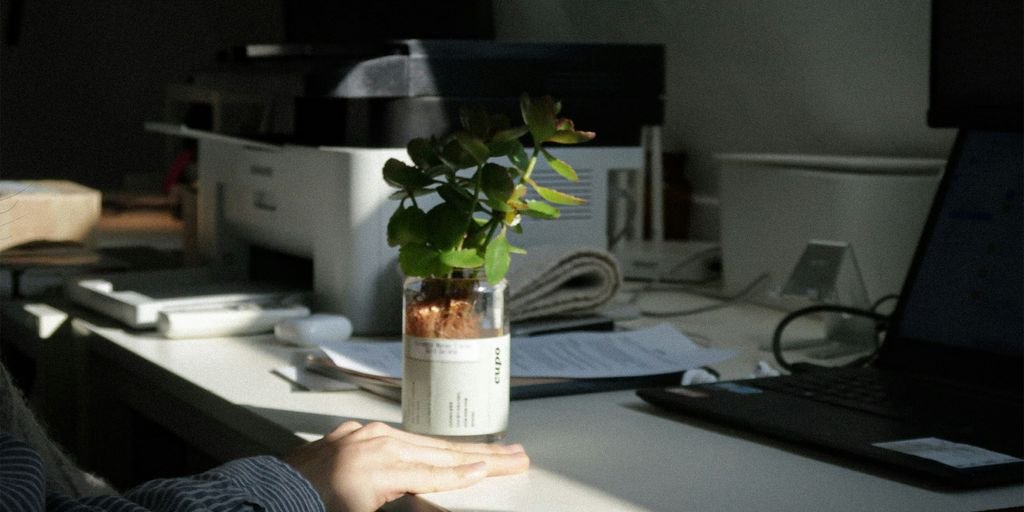
Nature’s Touch: Biophilic Workplace Design
- Incorporate Live Plants: From small potted plants on desks to larger floor plants and vertical gardens, greenery adds life and improves air quality.
- Maximize Natural Light: Arrange workspaces to take advantage of sunlight. Consider using lighter colors and reflective surfaces to bounce light around the room.
- Natural Materials and Views: Use wood, stone, and other natural textures. If possible, position workstations with views of outdoor spaces.
Connecting with nature indoors isn’t just about looks; it’s about creating an environment that supports mental clarity and reduces the feeling of being cooped up.
3. Eco Chic: Sustainable Materials
In 2025, the push for greener offices isn’t just a nice-to-have; it’s becoming a core part of how companies present themselves. We’re seeing a real shift towards using materials that are not only good for the planet but also look great and make people feel good about where they work. Think about furniture made from reclaimed wood or recycled plastics – these items tell a story about a company’s commitment to the environment. It’s about making those eco-credentials visible.
Companies are really starting to pay attention to the impact of their choices. It’s not just about reducing waste, though that’s a big part of it. It’s also about creating healthier indoor spaces. This means looking at things like low-VOC paints, which don’t release harmful chemicals into the air, and sustainable textiles for upholstery and carpets. Bamboo and cork are also making a comeback because they grow fast and are pretty durable.
- Recycled Wood: Gives a rustic, warm feel and diverts waste from landfills.
- Bamboo: A fast-growing, renewable resource that’s strong and versatile.
- Recycled Plastics: Can be transformed into durable surfaces and furniture.
- Low-VOC Paints & Finishes: Improves indoor air quality for a healthier environment.
The trend is clear: sustainability is becoming a visual statement. It’s a way to attract talent, especially younger generations who really care about these issues. When employees see that their workplace is actively trying to be more environmentally friendly, it builds pride and loyalty. It’s a win-win, really. Choosing materials that have a lower environmental impact is becoming standard practice, not just an option.
Making conscious material choices is more than just a design trend; it’s a reflection of a company’s values and its commitment to a healthier future for both its employees and the planet. It’s about creating spaces that feel good, do good, and look good.
4. Smart Technology Integration
In today’s world, offices are getting smarter, and it’s not just about having the latest gadgets. It’s about making the workspace work better for everyone. Think about things like automated lighting and climate control systems that adjust themselves based on who’s in the room or even the time of day. These systems can really help cut down on energy use, which is good for the planet and the company’s wallet. Plus, they help create a more comfortable environment for people working there.
We’re seeing more and more Internet of Things (IoT) devices being built right into the office furniture and structure. These can do things like help you find an available desk or book a meeting room easily using an app. It’s all about making the day-to-day operations smoother.
Smart Sensors for Efficiency
- Occupancy sensors: These can tell if a room or desk is being used, allowing lights and heating/cooling to adjust automatically. This saves energy when spaces are empty.
- Environmental sensors: Monitor air quality, temperature, and humidity to keep the workspace healthy and comfortable.
- Usage tracking: Data from sensors can show how different areas of the office are being used, helping to plan future layouts more effectively.
Automating for Comfort and Productivity
- Automated lighting: Lights can dim or brighten based on natural light levels or occupancy, reducing eye strain and saving power.
- Smart climate control: Systems learn preferences and occupancy patterns to maintain optimal temperatures without constant manual adjustments.
- Integrated AV: Meeting rooms are getting equipped with tech that makes presentations and video calls easier, like one-touch screen sharing and automatic camera adjustments.
The goal is to use technology to make the office more responsive to the people in it. This means spaces that adapt to our needs, making work feel less like a chore and more like a natural part of our day. It’s about creating an environment that supports focus, collaboration, and overall well-being through intelligent design.
We’re also seeing a rise in digital signage that can display important company news or even interactive maps. For those looking to improve their office setup, consider looking into modular ceiling systems that can integrate lighting and other tech features.
5. Acoustic Solutions
Open-plan offices are great for collaboration, but let’s be real, they can get loud. That’s why focusing on acoustic solutions is a big deal for 2025 office design. We’re talking about using materials that actually soak up sound, not just bounce it around. Think about wall panels made from recycled materials, ceiling tiles that look good and muffle noise, or even carpeting in busy spots. These aren’t just fancy add-ons; they make a real difference in how people can concentrate.
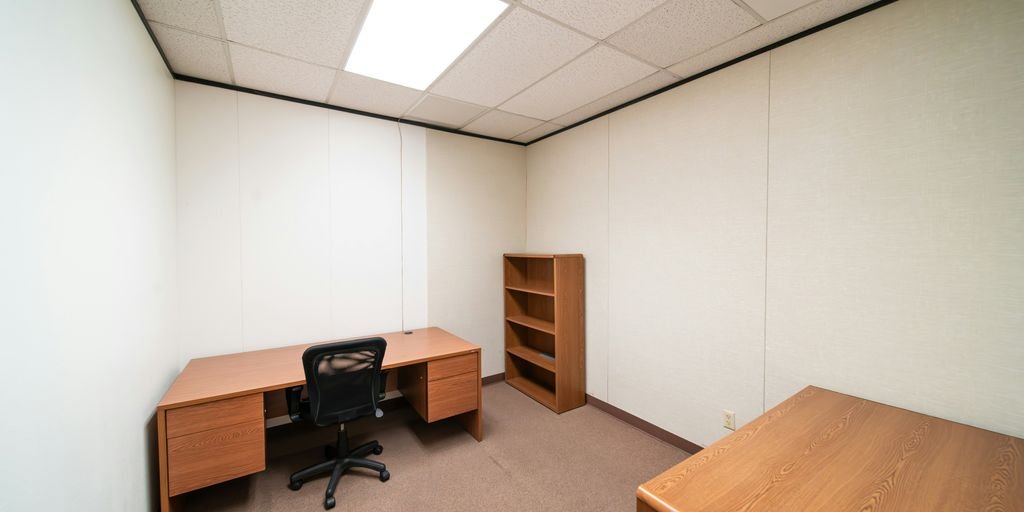
We also need to think about creating dedicated quiet areas. These are spots where someone can go to really focus on a task without distractions. It’s about giving people options for where they work best.
Here are some ways to tackle office noise:
- Acoustic Wall Panels: These can be decorative and functional, absorbing sound waves.
- Sound-Dampening Flooring: Carpets or specialized rubber flooring can significantly reduce impact noise.
- Acoustic Ceiling Tiles: Often overlooked, these can be a major factor in controlling overall room noise.
- Privacy Pods/Booths: Small, enclosed spaces are perfect for calls or focused work.
Creating a quieter office environment isn’t just about comfort; it’s about boosting productivity and reducing stress. When people can hear themselves think, they tend to do better work.
It’s also worth looking into furniture designed with sound absorption in mind. Some chairs and sofas are made with materials that help break up sound. For those needing serious quiet, portable soundproof booths are a great addition to any open-plan setup, offering a private space for important calls or deep concentration. Making these thoughtful choices helps create a more functional and pleasant workspace for everyone. We’re seeing a real shift towards offices that actively manage sound, and it’s a trend that benefits both employees and the bottom line. Investing in good acoustic panels is a smart move for any business looking to improve its work environment.
6. Health & Wellbeing Focus
Prioritizing People: The Rise of Wellness-Centric Workplaces
As we move into 2025, the focus on employee health and well-being isn’t just a nice-to-have; it’s becoming a core design principle. Companies are realizing that a healthy workforce is a productive workforce. This means creating spaces that actively support both physical and mental health. Think beyond just ergonomic chairs, though those are important too! We’re talking about a more holistic approach.
Key Elements for a Healthier Office:
- Ergonomics and Movement: Incorporating adjustable sit-stand desks and monitor stands is a big step. These allow employees to change their posture throughout the day, reducing strain and promoting better circulation. It’s about giving people options to work in a way that feels best for their bodies.
- Air Quality and Natural Light: Good ventilation and access to natural light can significantly impact mood and energy levels. Consider layouts that maximize daylight and invest in air purification systems. Even small changes, like strategic placement of plants, can make a difference.
- Mental Recharge Zones: Dedicated quiet areas or relaxation rooms are becoming essential. These spaces offer a retreat from the hustle and bustle, allowing employees to decompress, focus, or simply take a moment for themselves. It acknowledges that not everyone works best in an open, collaborative environment all the time.
- Biophilic Touches: Bringing nature indoors through plants, green walls, or natural materials helps create a calming atmosphere and can reduce stress. It’s a simple way to connect people with the outdoors, even when they’re inside.
The goal is to design environments where people feel good, can concentrate, and are supported in their overall health. It’s about creating a workspace that genuinely cares for its occupants.
Wellness Amenities and Integration
Many forward-thinking companies are now integrating wellness amenities directly into their office layouts. This could include on-site fitness centers, meditation rooms, or even healthy snack stations. The idea is to make well-being accessible and convenient throughout the workday. This trend reflects a deeper understanding of how the physical environment directly influences employee morale, engagement, and long-term health. Investing in these office solutions shows a commitment to employee welfare, which in turn can boost loyalty and reduce burnout. It’s a win-win for everyone involved.

7. Resimercial Aesthetics
Forget sterile cubicles and harsh fluorescent lights. The big idea for 2025 is “resimercial” design, a blend of residential comfort and commercial functionality. Think of it as bringing your favorite cozy living room vibes into the office. This trend is all about making workspaces feel more inviting and less like a traditional, stuffy corporate environment. It’s a direct response to the rise of remote work and the desire to create spaces that people actually want to be in, especially when they have the option to stay home.
Bringing the Comforts of Home In
So, what does this look like in practice? Expect to see more plush seating, like comfortable sofas and armchairs, alongside textured rugs and soft furnishings. Warm color palettes are making a comeback, moving away from stark minimalism. Personal touches, like curated art or decorative elements, will also play a bigger role in making a space feel more human and less institutional. It’s about creating an atmosphere that supports both focused work and relaxed collaboration.
Key Elements of Resimercial Design
- Soft Furnishings: Incorporating items like throw pillows, blankets, and upholstered furniture to add warmth and comfort.
- Warm Color Palettes: Utilizing earthy tones, muted pastels, and rich, inviting colors to create a welcoming ambiance.
- Natural Light & Materials: Maximizing natural light and using materials like wood, stone, and natural fibers to connect the space with nature.
- Varied Seating Options: Offering a mix of seating types, from ergonomic task chairs to more relaxed lounge seating, to accommodate different work styles.
The goal is to create a space that feels both productive and restorative, blurring the lines between where we work and where we relax. This approach aims to boost employee morale and creativity by making the office a more enjoyable place to spend time.
Technology Meets Design
While we’re embracing the cozy, technology isn’t taking a backseat. The resimercial trend integrates smart tech in ways that feel natural and unobtrusive. Think integrated charging stations that blend into furniture, smart lighting systems that adjust to natural light, and perhaps even sound-masking technology that creates a more peaceful atmosphere without being obvious. It’s about using technology to support comfort and productivity, not complicate it. For those looking to outfit their next commercial project with innovative, design-forward systems, exploring custom office solutions can help achieve this blend of comfort and cutting-edge functionality.
8. Diversity & Inclusion
Designing an office that works for everyone is a big deal now. It’s not just about having a desk and a chair anymore. We’re seeing more thought put into spaces that support different needs, like gender-neutral restrooms, quiet rooms for focus, and private areas for nursing parents. These thoughtful additions make the workplace feel more welcoming and considerate of everyone’s personal requirements.
It’s also about acknowledging neurodiversity. Think about spaces that offer varied sensory experiences. Some people might need a quiet corner away from the main hustle, while others might thrive in a more dynamic, open area. Providing options helps people do their best work.
Here are a few ways to make your office more inclusive:
- Quiet Zones: Dedicated areas for focused work, free from distractions.
- Sensory Rooms: Spaces with adjustable lighting and sound, or calming elements.
- Flexible Furniture: Options like standing desks or comfortable seating arrangements.
- Prayer/Meditation Rooms: Private spaces for reflection or religious observance.
The goal is to create an environment where every individual feels seen, respected, and able to contribute fully. This isn’t just good for morale; it’s good for business too, bringing in a wider range of perspectives and talents. Making your office a place that truly reflects [office space design for 2025] means embracing these diverse needs from the ground up.
9. Community Zones
Social Hubs: Community Zones
In 2025, offices are really leaning into creating spaces where people can just hang out and connect. It’s not just about having a place to grab coffee; it’s about designing areas that naturally encourage interaction and build a sense of togetherness. Think comfortable seating arrangements, maybe some games, or even communal dining spots. These zones are becoming super important because, honestly, people want to come to the office for the social side of things, not just to sit at a desk alone. It’s about making the workplace feel more like a neighborhood hub, a place where you actually want to be.
- Encourage spontaneous conversations: Design layouts that put people in proximity to each other, like around a central coffee station or a comfortable lounge area.
- Support diverse activities: Include flexible furniture that can be easily rearranged for different group sizes and purposes, from quick chats to informal team huddles.
- Integrate amenities: Consider adding elements like shared kitchens, game tables, or even quiet nooks for focused relaxation to cater to various needs.
The focus is shifting towards spaces that support our basic social needs. When people feel a sense of belonging and can easily connect with others, they’re more likely to engage with their work environment. It’s about shared experiences and building that team spirit.
These community zones are key to making the office a destination again. They help combat the isolation that can come with remote work and remind everyone why being together in person has its perks. It’s a smart way to boost morale and collaboration, making the office a place that truly supports the social wellbeing of its people. We’re seeing a lot more thought put into how these areas can be reconfigured for different events or just everyday use, really tapping into what makes people feel connected. This trend is all about making the office a place that feels alive and welcoming, reflecting the broader urban trend of creating vibrant, shared neighborhood hubs. It’s a big part of creating inspiring office design ideas for 2025.
10. Hybrid Meeting Spaces
As more people work from home some days, making sure everyone can connect during meetings is a big deal. Hybrid meeting spaces are designed to make this easy. Think about rooms with really good cameras and microphones, plus fast internet. This way, people in the office and people joining from their own homes can all see and hear each other clearly. It’s all about making sure collaboration doesn’t skip a beat, no matter where you are.
Key Features for Effective Hybrid Meetings:
- High-Quality Audio-Visual Equipment: Invest in good cameras that can capture the whole room and clear microphones that pick up everyone’s voice. This makes remote participants feel more included.
- Reliable Connectivity: Strong Wi-Fi or wired internet is non-negotiable. Dropped connections are frustrating for everyone involved.
- Flexible Seating Arrangements: Design the space so that both in-person and remote attendees have a good view of the screen and each other. This might mean tiered seating or movable furniture.
- Interactive Technology: Tools like digital whiteboards or screens that allow screen sharing from multiple devices can really help with brainstorming and group work.
Creating these spaces isn’t just about technology; it’s about designing an environment where everyone feels like they’re in the same room, contributing equally. It’s a big shift from just having a conference table and a laptop.

Making the Space Work:
- Consider Room Size: A small huddle room needs different tech than a large boardroom.
- Easy to Use: The technology should be intuitive, so people don’t waste meeting time trying to figure it out.
- Comfort is Key: Even with great tech, uncomfortable chairs or poor lighting can distract from the meeting’s purpose.
Wrapping It Up: Your Future Workspace Awaits
So, there you have it. The office scene for 2025 is all about making spaces that work better for people. Think flexible layouts, a bit of nature brought indoors, and smart tech that just makes sense. It’s not just about looking good, though that’s part of it. It’s really about creating places where people feel good, can get their work done, and maybe even enjoy coming in. Whether you’re revamping a whole floor or just tweaking a corner, keeping these ideas in mind can make a big difference. Your workspace should feel good to be in, and these trends are a great way to get there.
Frequently Asked Questions
How can I create flexible workspaces in a small office?
For smaller offices, use furniture that serves multiple purposes, like desks that fold or walls that move. Setting up different areas for talking, quiet work, and meetings helps make the most of your space without making it feel cramped.
How do I keep things private in open, flexible workspaces?
You can add moving walls, special quiet rooms, or even plants to create private spots in open areas. These can be moved around to give privacy when needed without changing the open feel of the office.
What are some creative ways to use a home-like style without losing professionalism?
Use nice furniture that feels cozy, like comfy sofas and chairs, and add elements like plants or soft lighting. This makes the office feel more like home while still looking professional.
How does bringing nature into the office help?
Focus on adding natural elements like plants, water, or big windows with lots of light. These things can make an office feel more calming and inspiring, helping people feel better and work better.
How does smart technology improve the office environment?
Smart technology can help control lights and temperature automatically. This makes the office more comfortable and helps save energy.
How can I reduce noise in the office?
Use materials that absorb sound, like special wall panels, carpets in busy spots, or ceiling tiles made to reduce noise. Also, having quiet areas for focused work helps people concentrate better.



